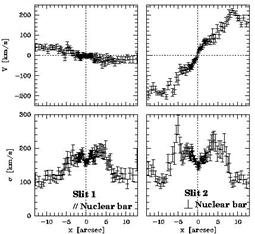Fuelling of nuclear galactic regions
It is now well establish that the gravitational torque exerted by a stellar bar on the gas is responsible for the gas angular momentum lost. The gas thus spirals towards the nucleus and piles up in the central region, in general in a circumnuclear ring. Such mechanism is however insufficient to explain the feeding of a potential nuclear black hole. Shlosman et al (1990) suggested that a nuclear bar, embedded in the larger scale stellar bar could bring the gas from the circumnuclear ring towards the nucleus. I tackled the problem of the nuclear feeding first by the observational side. A multi-wavelength surface photometry analysis of roughly 50 objects has revealed non‑axisymmetric structures as small as twice the seeing (Wozniak et al 1995, Friedli et al 1996, Wozniak et al 1998, Greusard et al 2000). These studies brought a number of constraints on dynamical models of the central regions. For instance, the position‑angle between primary and secondary bars neither takes particular values (e.g. 0 or 90°), supporting the idea of a peculiar dynamical coupling between both bars, as suggested by N‑body simulations.
An unexpected result has been obtained on the kinematics of such nested bars systems. Using the NIR spectrograph ISAAC on VLT, we got spectra of the CO band at 2.3µm in absorption for 4 double‑barred galaxies. We discovered that the stellar velocity dispersion in the central region displays a drop instead of the expected peak (Emsellem et al 2001, ESO Press Release 18‑01 on 2001 August 14th).
I succeed to explain this challenging result thanks to my N-body simulations coupling stars, gas and star formation (Wozniak et al. 2003). Indeed, stars formed by gas accumulation in the central regions (young population) have smaller velocity dispersions than older stars (i.e. the initial stellar population present at the beginning of the simulation). The initial population is dynamically heated by the coming out of the stellar bar and the bulge growth. When the young population is massive enough, its ‘cold’ kinematics dominates the global central region kinematics. Moreover, if we convert the mass in luminosity, this effect is amplified because M/L in K band is very low for young stars. The velocity dispersion drop is thus indirectly due to intense star formation in the regions close to the nucleus, which is active in most of our objects. Further experiments where we switched off star formation recipes in our simulation confirmed this effect and showed that a rather low SFR is needed to keep up the kinematical drop (Wozniak & Champavert 2006).


Figure 1: Top panel: example of a double-barred galaxy (Greusard et al 2000). In this instance, bars are aligned and separated by a nuclear ring. Bottom panel: an N-body+SPH simulation of a double-barred galaxy. Gas distribution (left), stellar particles formed (right). Edge-on (top) and face-on (bottom) views.


Figure 2: Top panel: Line‑of‑sight velocity and velocity dispersion curves for NGC 1097, along the major and minor axes of the nuclear bar. The central velocity dispersion drop is obvious (Emsellem et al 2001). Bottom panel: Line‑of‑sight velocity and velocity dispersion curves for N-body simulations including stars, gas and star formation. Empty triangles represent young stars, empty lozenges old stars and filled squares the luminosity‑weighted sum of both populations. The central velocity dispersion drop is clearly visible in my simulations (Wozniak et al 2003).
You can follow any responses to this entry through the RSS 2.0 feed. Both comments and pings are currently closed.